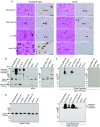Prion-Like Seeding of Misfolded α-Synuclein in the Brains of Dementia with Lewy Body Patients in RT-QUIC
- PMID: 28550528
- PMCID: PMC5884914
- DOI: 10.1007/s12035-017-0624-1
Prion-Like Seeding of Misfolded α-Synuclein in the Brains of Dementia with Lewy Body Patients in RT-QUIC
Abstract
The prion-like seeding of misfolded α-synuclein (αSyn) involved in the pathogenesis of Lewy body diseases (LBD) remains poorly understood at the molecular level. Using the real-time quaking-induced conversion (RT-QUIC) seeding assay, we investigated whether brain tissues from cases of dementia with Lewy bodies (DLB), which contain serine 129 (Ser129)-phosphorylated insoluble aggregates of αSyn, can convert Escherichia coli-derived recombinant αSyn (r-αSyn) to fibrils. Diffuse neocortical DLB yielded 50% seeding dose (SD50) values of 107~1010/g brain. Limbic DLB was estimated to have an SD50 value of ~105/g brain. Furthermore, RT-QUIC assay discriminated DLB from other neurological and neurodegenerative disorders. Unexpectedly, the prion-like seeding was reconstructed in reactions seeded with oligomer-like species, but not with insoluble aggregates of r-αSyn, regardless of Ser129 phosphorylation status. Our findings suggest that RT-QUIC using r-αSyn can be applied to detect seeding activity in LBD, and the culprit that causes prion-like seeding may be oligomeric forms of αSyn.
Keywords: Dementia with Lewy bodies (DLB); Prion; Real-time quaking-induced conversion (RT-QUIC); α-synuclein.
Conflict of interest statement
Conflict of Interest
The authors declare that they have no conflict of interest.
Figures






Similar articles
-
RT-QuIC and Related Assays for Detecting and Quantifying Prion-like Pathological Seeds of α-Synuclein.Biomolecules. 2022 Apr 14;12(4):576. doi: 10.3390/biom12040576. Biomolecules. 2022. PMID: 35454165 Free PMC article. Review.
-
[Real-time Quaking-induced Conversion Analysis of Prion-like Seeding Activity of Pathological α-Synuclein].Yakugaku Zasshi. 2019;139(7):999-1005. doi: 10.1248/yakushi.18-00165-3. Yakugaku Zasshi. 2019. PMID: 31257259 Review. Japanese.
-
RT-QuIC Using C-Terminally Truncated α-Synuclein Forms Detects Differences in Seeding Propensity of Different Brain Regions from Synucleinopathies.Biomolecules. 2021 May 31;11(6):820. doi: 10.3390/biom11060820. Biomolecules. 2021. PMID: 34072869 Free PMC article.
-
Establishment of Method for the Determination of Aggregated α-Synuclein in DLB Patient Using RT-QuIC Assay.Protein Pept Lett. 2021;28(1):115-120. doi: 10.2174/0929866527666200420105352. Protein Pept Lett. 2021. PMID: 32310037
-
Streamlined alpha-synuclein RT-QuIC assay for various biospecimens in Parkinson's disease and dementia with Lewy bodies.Acta Neuropathol Commun. 2021 Apr 7;9(1):62. doi: 10.1186/s40478-021-01175-w. Acta Neuropathol Commun. 2021. PMID: 33827706 Free PMC article.
Cited by
-
Development and validation of an expanded antibody toolset that captures alpha-synuclein pathological diversity in Lewy body diseases.NPJ Parkinsons Dis. 2023 Dec 7;9(1):161. doi: 10.1038/s41531-023-00604-y. NPJ Parkinsons Dis. 2023. PMID: 38062007 Free PMC article.
-
RT-QuIC and Related Assays for Detecting and Quantifying Prion-like Pathological Seeds of α-Synuclein.Biomolecules. 2022 Apr 14;12(4):576. doi: 10.3390/biom12040576. Biomolecules. 2022. PMID: 35454165 Free PMC article. Review.
-
Ultrastructural and biochemical classification of pathogenic tau, α-synuclein and TDP-43.Acta Neuropathol. 2022 Jun;143(6):613-640. doi: 10.1007/s00401-022-02426-3. Epub 2022 May 5. Acta Neuropathol. 2022. PMID: 35513543 Free PMC article. Review.
-
Brain region-specific susceptibility of Lewy body pathology in synucleinopathies is governed by α-synuclein conformations.Acta Neuropathol. 2022 Apr;143(4):453-469. doi: 10.1007/s00401-022-02406-7. Epub 2022 Feb 9. Acta Neuropathol. 2022. PMID: 35141810 Free PMC article.
-
α-Synuclein Seeding Assay Using RT-QuIC.Methods Mol Biol. 2021;2322:3-16. doi: 10.1007/978-1-0716-1495-2_1. Methods Mol Biol. 2021. PMID: 34043187
References
MeSH terms
Substances
LinkOut - more resources
Full Text Sources
Other Literature Sources
Medical
Molecular Biology Databases

